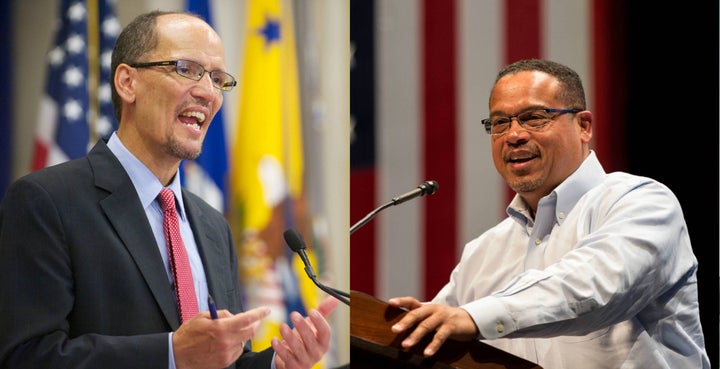
This piece was co-authored by EJ Marin and Ethan Fitzgerald.
This weekend, the Democratic National Committee (DNC) will gather for its winter meeting. On Saturday, February 25th, 447 voting members will elect a new Democratic Party Chair from a field of 10 candidates. While most analyses of the election focus on the spirited contest among the candidates, including front-runners Minnesota Congressman Keith Ellison and former Secretary of Labor Tom Perez, we want to zero in on a key feature: the voting method governing the election.The majority requirement for becoming chair ensures that the winner will reflect more consensus than we see in most of our governmental elections. And while there have been useful explainers like this November overview by Andrew Prokop in Vox, blog postings by DNC member Frank Leone and the DNC’s own FAQ, the actual voting method hasn’t been getting the attention it deserves.
As is common with political parties at all levels in the United States and other nations like the United Kingdom and Canada (where the main opposition parties, the Conservative Party and the New Democratic Party, will both use ranked choice voting as part of their leadership elections this year), the Democratic National Committee Charter requires that the chair be elected with a majority rather than a plurality. The specific rules for how to uphold this majority requirement were decided at a December 2016 meeting of the Rules and Bylaws Committee. Rule 1.c.2) specifies that:
“If a new Chairperson is not elected on the first ballot, a second ballot shall be conducted. If a new Chairperson is not elected on the second ballot, additional ballots shall be conducted until a new Chairperson is elected, but the candidate receiving the least number of votes on each preceding ballot beginning at the third ballot, shall be eliminated.”
In other words, the 447 members will vote. If no candidate has at least 224 votes (that is, 50% plus one), then they will vote again. No candidate is automatically eliminated, but candidates will have the option to withdraw before the second round. If there is still no majority winner, then repeated rounds will take place, before which the candidate in last place will be automatically eliminated before each new round of voting. The rounds of voting continue until one candidate receives a majority of the vote -- which of course is guaranteed once the field is reduced to two.
For voting method aficionados, the algorithm behind the process should be familiar: it’s just like ranked choice voting (RCV, also called “instant runoff voting” and “preferential voting”) when used to elect one candidate. Both repeated voting and RCV uphold majority rule by requiring 50% plus one to win and, when no one achieves that goal, it’s “last candidate out.” The one difference is that with repeated voting, you can change your mind based on what you’re observing -- or, as is frequently the case, what deals are made among competing factions and candidates.
The value of seeking consensus has made majority requirements popular in parties and major private associations throughout the United States and the world. Like most guides for parliamentarians, Robert’s Rules of Order recommends repeated voting with a majority requirement in internal elections -- and then spell out ranked choice voting as the preferred method when there isn’t time for multiple rounds of voting or when voting by mail without a runoff.
Republicans have similar rules, As explained in FairVote’s account of the 2009 Republican National Committee chair election, six rounds of voting were needed to elect Michael Steele, who came from behind to win a majority. State and county parties usually have majority requirements, and ranked choice voting has been used in recent years by Republicans in states like Utah and Democrats in states like Iowa, Texas and Virginia.
In addition to taking more time than using a single ranked ballot, the fact that repeated voting incentivizes deal-making and politicking between rounds can cause controversy. This and the sheer time involved in holding repeated voting elections has made ranked choice voting an increasingly popular method for electing political party leaders internationally. Its use in US party elections is on the rise as well, with Iowa Democrats electing their state chair with ranked choice voting for the first time this year. Literally hundreds of major associations and students at colleges and universities now use RCV.
Ironically, most governmental elections in the United State use plurality voting, in which the candidate with the most votes wins, even if they received less than a majority. In contests with three or more candidates like the election for DNC chair, this can happen easily. The DNC’s majority requirement ensures that its next chair will be a candidate who has earned a majority of support from voting members and likely will be a consensus leader within the party.
That endeavor is all the more important for Democrats in the wake of the contentious contest between Hillary Clinton and Bernie Sanders in last year’s presidential primaries. Democrats will be looking to repeat the Iowa Democratic Party’s feat accomplished with RCV this year, where the winner was seen as bridging the Clinton and Sanders camps. Whether Tom Perez (more associated with Hillary Clinton and the Obama administration) or Keith Ellison (more associated with Sanders) can win will depend on their success in achieving consensus during the rounds of voting. As in a ranked choice voting election, they must ask for second and third choice support from backers of candidates who are eliminated early. If they don’t succeed, then party members may turn to another compromise candidate.
History shows that the use of majority requirements and ranked choice voting leads to compromise and agreement even between deeply opposed political factions. Democrats can look forward to electing a new chair who not only captures the support of the majority of the DNC but helps establish a more unified party. There’s a lesson for the nation in that process. Maine will be the first state to use RCV for all its big elections next year after a string of governors were elected with less than 40 percent of the vote in multi-candidate contests, while a growing number of cities have adopted RCV. Both parties often experience non-majority winners in primaries, as was true in most Republicans presidential primaries in 2016. We increasingly see significant minor party and independent candidates in general elections, including in 2016 when six U.S. Senators won without a majority and 11 states were won without a majority in the presidential race. Let’s hope the political parties take the wisdom they have gleaned from their own elections and apply it to elections for all of us.
The Oscar for Best Picture is decided by ranked choice voting. To cast a RCV ballot for Best Picture, Best Actress, and Best Actor, visit Oscars polls.
